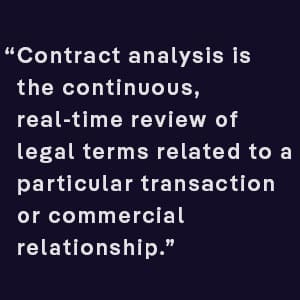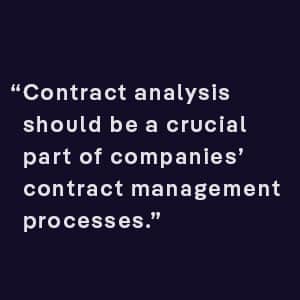Today’s contracts play a crucial part in organizational processes and, as such, are instrumental to companies’ success. A significant amount of time and resources are spent drafting, reviewing, and negotiating business agreements. Nevertheless, after the signing of contracts, they may be stored away — and never be seen again — unless something goes terribly wrong, of course.
Below, we will explain what contract analysis means exactly — within the context of contract management — and how to adopt and implement effective contract analysis within your organization.
What is Contract Analysis
Contract analysis is the continuous, real-time review of legal terms related to a particular transaction or commercial relationship. The process is used throughout the contract lifecycle to keep track of and examine this important information within agreements. For the most part, the latter can be related to contract status and clauses, as well as changes in organizational policies. If it is beneficial to the company, contract analysis can also be used as a means to compare previous versions of agreements.
Analyzing the contents of the contracts that organizations hold goes a long way in determining the risk profile of companies; providing a deeper look into operations, and instructing how businesses can be more efficient, effective, and customer-friendly.
Why is Contract Analysis Important?
Modern contracts are the foundations of business relationships. They also reflect what is going on within the business and represent some of the richest sources of data available to organizations. By breaking down important contractual information, lawyers and contract managers find it easier to understand the agreements that their companies hold. They receive instantaneous and in-depth insights into these valuable documents, too. And by properly analyzing contacts, more broadly, lawyers and contract managers can better pick up on inefficiencies in their everyday contracting processes, as mentioned above.
Without adequate contract visibility or oversight, agreements can contain profiting-reducing errors. These include the following:
- Unspecific clauses that do not provide effective outcomes
- Lack of dispute resolution provisions
- Insufficient protection against liabilities and termination effects
- Outdated language that does not reflect the latest developments
- Outdated language that does not reflect new regulations or laws
- Unforeseen conflicts between existing agreements
Benefits of Contract Analysis
Organizations must review their day-to-day processes and performance, during the course of the year. Such thorough reviews help them gain a better understanding of these areas and find ways to improve them. Naturally, contracts are no exception. In fact, the most effective contract analysis offers the following key benefits, which can be experienced across departments, companies, and industries.
Improved Future Contracting Processes
Every contract management professional makes mistakes — at some point in the contracting process or another. The good news is that contract analysis facilitates the identification and avoidance of errors in agreements. Think clauses or terms that provide the opposite result of what was intended originally.
Risk Mitigation
Just about every company enters into agreements, knowing that it could fail to meet agreed-upon obligations, and subsequently face fines or legal action. However, a thorough contract analysis helps companies identify those areas with various liabilities, along with the level of risk associated with the same. It also allows teams to pinpoint specific contractual risks, possibly transforming them into sources of future revenue.
Improved Decision Making
Generally, the more scrutiny an agreement is under, the more a contract analysis process detects and highlights what could pose a legal or financial risk potentially. This, in turn, helps companies make more accurate, strategic decisions later on.
Contract Analysis Steps
When it comes to conducting an analysis of agreements, the process or steps vary from organization to organization. After all, contracts are rather intricate and technical. They thoroughly outline the agreements that companies enter and, therefore, contain vast amounts of critical, actionable data.
Contract analysis should be a crucial part of companies’ contract management processes, as a matter of consequence. The ongoing analysis of agreements allows companies to break down voluminous, complex information into smaller, easily digestible information. It then helps them gain a better understanding of their individual contracts, improve customer or partner relationships, and drive better decision-making, as mentioned above.
Manage Contracts With AI-driven Contract Management Software
Traditionally, contract analysis tasks have required much time and effort. However, legal and contract management teams have turned away from outdated, manual processes — toward legal technology solutions that automate more and more contract analysis tasks. Using the latter is not only far less time-consuming but also much more accurate and cost-effective.
AI-based contract management software like ContractPodAi Cloud offers digital tools that automate workflows tied to initiating, approving and monitoring contracts. And this helps to accelerate sales cycles, and improve the visibility of legal and compliance threats while reducing overall costs. It then serves as a smart repository, allowing remote access to and advanced searches of the system. This functionality allows legal and other users to extract contractual information, such as when a contract needs to be renewed, any time they need it. As a result, that information can be examined, compared, and converted into useful contract management reports.
Without software, such as a contract lifecycle management (CLM) system, companies cannot capture and analyze each step of the contract lifecycle — with a great deal of efficiency and effectiveness. They are more likely to have misconceptions about those particular steps, along with the contracting responsibilities associated with them, too. This, of course, creates a number of challenges, ranging from contract execution and approval to renewal date ownership and agreement discontinuation. This can also prevent the building of new performance requirements — those that address any vendor concerns or hold vendors to higher standards.
Fortunately, a CLM system captures every transaction, customer, and vendor, as well as potential partnerships. It then helps teams view aggregate data across the system and recognize patterns that are emerging in their agreements. Best of all, it leverages artificial intelligence and machine learning, ultimately reducing the amount of work necessary to create value from companies’ contractual data.
If you want to learn more about AI-driven contract analysis, read our handy Contract Management Fundamentals Guide. Or contact ContractPodAi today to schedule a demo.
Author:

Sarvarth Misra
Connect with us on Linkedin





